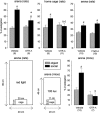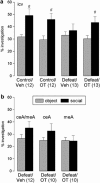The neuropeptide oxytocin facilitates pro-social behavior and prevents social avoidance in rats and mice
- PMID: 21677650
- PMCID: PMC3176581
- DOI: 10.1038/npp.2011.95
The neuropeptide oxytocin facilitates pro-social behavior and prevents social avoidance in rats and mice
Abstract
Social avoidance and social phobia are core symptoms of various psychopathologies but their underlying etiology remains poorly understood. Therefore, this study aims to reveal pro-social effects of the neuropeptide oxytocin (OT), under both basal and stress-induced social avoidance conditions in rodents using a social preference paradigm. We initially show that intracerebroventricular (i.c.v.) application of an OT receptor antagonist (OTR-A) in naïve male rats (0.75 μg/5 μl), or mice (20 μg/2 μl), reduced social exploration of a novel con-specific indicative of attenuated social preference. Previous exposure of male rats to a single social defeat resulted in loss of their social preference and social avoidance, which could be restored by i.c.v. infusion of synthetic OT (0.1 μg/5 μl) 20 min before the social preference test. Although the amygdala has been implicated in both social and OT-mediated actions, bilateral OTR-A (0.1 μg/1 μl) or OT (0.01 μg/1 μl) administration into various subnuclei of the amygdala did not affect basal or stress-induced social preference behavior, respectively. Finally, we demonstrate the social specificity of these OT-mediated effects by showing that neither an arginine vasopressin V1a receptor antagonist (0.75 μg/5 μl, i.c.v.) nor the anxiogenic drug pentylenetetrazol (15 mg/kg, i.p.) altered social preference, with OTR-A not affecting non-social anxiety on the elevated plus-maze. Overall, the data indicate that the basal activity of the endogenous brain OT system is sufficient to promote natural occurring social preference in rodents while synthetic OT shows potential to reverse stress-induced social avoidance and might thus be of use for treating social phobia and social dysfunction in humans.
Figures





Comment in
-
Can understanding social preferences in rodents lead to novel pharmacotherapies for social anxiety and avoidance in psychiatric disorders?Neuropsychopharmacology. 2011 Oct;36(11):2151-2. doi: 10.1038/npp.2011.124. Neuropsychopharmacology. 2011. PMID: 21918516 Free PMC article. No abstract available.
References
-
- Arakawa H, Arakawa K, Deak T. Oxytocin and vasopressin in the medial amygdala differentially modulate approach and avoidance behavior toward illness-related social odor. Neuroscience. 2010;171:1141–1151. - PubMed
-
- Argiolas A, Melis MR. The role of oxytocin and the paraventricular nucleus in the sexual behaviour of male mammals. Physiology Behavior. 2004;83:309–317. - PubMed
-
- Barberis C, Tribollet E. Vasopressin and oxytocin receptors in the central nervous system. Crit Rev Neurobiol. 1996;10:119–154. - PubMed
Publication types
MeSH terms
Substances
LinkOut - more resources
Full Text Sources
Miscellaneous

